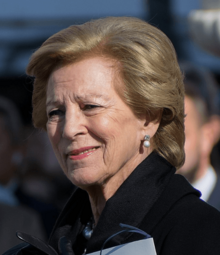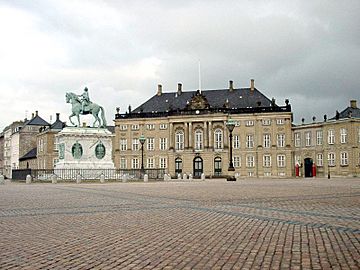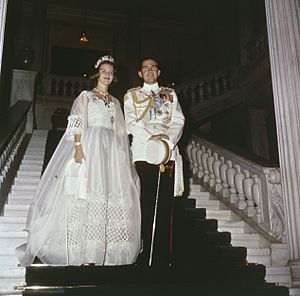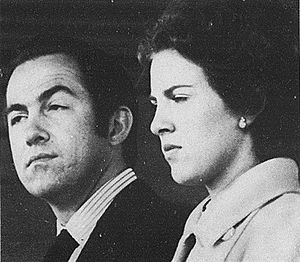Queen Anne-Marie of Greece facts for kids
Quick facts for kids Anne-Marie |
|||||
|---|---|---|---|---|---|

Anne-Marie at her husband's funeral in 2023
|
|||||
| Queen consort of the Hellenes | |||||
| Tenure | 18 September 1964 – 1 June 1973 | ||||
| Born | Princess Anne-Marie of Denmark 30 August 1946 Amalienborg Palace, Copenhagen, Denmark |
||||
| Spouse | |||||
| Issue |
|
||||
|
|||||
| House | Glücksburg | ||||
| Father | Frederik IX of Denmark | ||||
| Mother | Ingrid of Sweden | ||||
Anne-Marie (born Princess Anne-Marie Dagmar Ingrid of Denmark, 30 August 1946) is a Danish princess. She became Queen of Greece when she married King Constantine II on 18 September 1964. She was queen until the Greek monarchy was ended on 1 June 1973.
Anne-Marie is the youngest daughter of Frederik IX of Denmark and Ingrid of Sweden. She married Constantine in 1964 and became queen consort of Greece. They had five children: Princess Alexia, Crown Prince Pavlos, Prince Nikolaos, Princess Theodora, and Prince Philippos. As queen, Anne-Marie worked for a charity called "Her Majesty's Fund." This group helped people in need.
In 1967, Anne-Marie and her family had to leave Greece because a military government took over. They went to Rome and later moved to London. The Greek monarchy was officially ended in 1973. Anne-Marie and her family lost their Greek citizenship and their property. They took their case to the European Court of Human Rights. With the money she received, Anne-Marie started the "Anne-Marie Foundation." This foundation helped people in rural areas of Greece. In 2013, she and Constantine moved back to Greece. They moved to Athens in 2022, where Constantine passed away in January 2023.
Contents
Early Life and Family
Birth and Royal Family
Princess Anne-Marie was born on 30 August 1946. Her birthplace was Frederik VIII's Palace in Copenhagen, Denmark. This palace is part of the Amalienborg Palace complex. She was the third and youngest daughter of Crown Prince Frederik and Crown Princess Ingrid of Denmark. Her father later became King Frederik IX. Her mother was a princess of Sweden.
Anne-Marie has two older sisters: Princess Margrethe (who later became queen of Denmark) and Princess Benedikte. Anne-Marie was baptised on 9 October 1946. Many important people were her godparents, including her grandparents and other European royals.
Royal Connections
Anne-Marie is a great-great-granddaughter of both Queen Victoria and Christian IX of Denmark. This means she is related to many royal families in Europe. Her husband, Constantine II, was also a great-great-grandchild of Queen Victoria and Christian IX. Anne-Marie is the aunt of Frederik X of Denmark. She is also a first cousin of Carl XVI Gustaf of Sweden.
Childhood and Education
Princess Anne-Marie and her sisters grew up in palaces in Copenhagen and North Zealand. They spent summer holidays at Gråsten Palace. In 1947, her grandfather, Christian X, passed away. Her father became King Frederik IX.
At that time, only males could become king in Denmark. Since Anne-Marie's parents had no sons, her uncle, Prince Knud, was expected to become king. However, a new law in 1953 changed this. It allowed women to inherit the throne if they had no brothers. This meant her eldest sister, Margrethe, became the next in line to the throne. Anne-Marie became third in line.
Anne-Marie went to N. Zahle's School in Copenhagen from 1952 to 1961. She then attended boarding schools in Switzerland. These included the Chatelard School for Girls and the Institut Le Mesnil. After her schooling, Anne-Marie worked with children for a few years. Her mother wanted her to learn how to be a good homemaker.
Marriage to King Constantine II
Anne-Marie first met her future husband, Constantine, in 1959. She was 13 years old. Constantine was the Crown Prince of Greece. They met again in Denmark in 1961. Constantine told his parents he wanted to marry Anne-Marie. They became secretly engaged because Anne-Marie's father thought she was too young.
They met again in Athens in 1962 at the wedding of Constantine's sister, Princess Sophia of Greece and Denmark. Anne-Marie was a bridesmaid. They spent time together and told their families about their engagement. Their engagement was announced to the public in 1963. After this, Anne-Marie began studying Greek history and learning the Modern Greek language.
Constantine's mother wanted a very expensive wedding. The Danish royal family did not agree. They eventually decided to spend two million dollars on the wedding. On 6 March 1964, Constantine's father, King Paul, passed away. Constantine became King of the Hellenes. Anne-Marie and Constantine were married on 18 September 1964. This was just two weeks after Anne-Marie's 18th birthday. The wedding took place in the Metropolitan Cathedral of Athens. Anne-Marie changed her religion from Lutheranism to the Greek Orthodox Church in April 1965. When she married a foreign ruler, Anne-Marie gave up her right to the Danish throne for herself and her children.
Life as Queen of the Hellenes
As Queen of Greece, Anne-Marie's main job was to provide an heir to the throne. She spent a lot of her time working for a charity called "Her Majesty's Fund." This group was started by her mother-in-law, Queen Frederica. It helped poor and disadvantaged people. Anne-Marie also worked closely with the Red Cross and other charities.
On 10 July 1965, Queen Anne-Marie gave birth to her first child, Princess Alexia of Greece and Denmark. Alexia was next in line to the throne until her brother, Crown Prince Pavlos, was born on 20 May 1967. At this time, there was political trouble in Greece. In April 1967, a group of Greek soldiers took over the government. This started a military dictatorship. The royal family was not aware of this plan. To avoid conflict, Constantine and Anne-Marie agreed to recognize the new government. However, many people thought they supported the takeover.
The next month, Anne-Marie gave birth to Pavlos. He immediately became the Crown Prince. At his baptism, Anne-Marie and Constantine chose Queen Frederica as his godmother. They also chose the Hellenic Army as a godfather figure. Many people saw this as the royal family supporting the military government. Because of the military takeover, relations between Greece and Denmark became difficult. No one from the Danish royal family was allowed to attend Pavlos's baptism. Anne-Marie and Constantine were also not invited to the wedding of Anne-Marie's sister, Margrethe II of Denmark, in June 1967.
Exile from Greece
In December 1967, Constantine tried to overthrow the military government. His attempt failed. The military government then strongly advised Anne-Marie and Constantine to leave Greece. They were forced into exile. Anne-Marie and Constantine fled to Italy. They first stayed at the Greek Embassy in Rome. After two months, they moved to a villa in Rome. They rented a large villa from Countess Cristina Paolozzi for the next five years.
Anne-Marie had a miscarriage in early 1968. In February 1969, she gave birth to Prince Nikolaos of Greece and Denmark. Anne-Marie and Constantine started a small school in their villa. This was to help their children learn about Greek culture. Even though they were in exile, Anne-Marie and Constantine were still officially the monarchs of Greece. The military government paid them monthly. They were still allowed to represent Greece at international royal events. For example, they attended the 21st birthday of Charles, Prince of Wales, in 1969. One of the last events they attended as monarchs was the funeral of Anne-Marie's father, Frederik IX, in 1972.
The Monarchy Ends

The military government in Greece began to distance itself from the monarchy. In 1972, Constantine's face was removed from coins. A phoenix, a symbol of the Greek military, replaced it. There was growing opposition to the military government. This led to the monarchy being abolished in 1973. Anne-Marie and Constantine were officially removed from the throne on 29 July 1974. This was decided by a public vote.
The royal family lost their monthly payments from the government. They had to leave their home in Rome. Anne-Marie's sister, Margrethe II, allowed them to stay at Amalienborg in Denmark for a year. Anne-Marie then moved with her family to England. They lived first in Chobham, Surrey, and later in Hampstead, London.
The military government in Greece fell in 1974. This happened after a failed attempt to unite Greece and Cyprus. It was hoped that the King and Queen would be restored. However, another public vote confirmed that the monarchy would remain abolished. The new Greek government continued to keep Anne-Marie and her family in exile. They were not allowed to enter Greece. They were even denied entry for Queen Frederica's funeral in 1981. The Spanish royal family helped them get permission to return for just one day for the funeral.
In London, Anne-Marie and Constantine started the Hellenic College of London. This school helped their children learn Greek language and culture. Other royal families, like the Spanish, Danish, British, Swedish, and Norwegian royals, supported them. They also received money from the King of Jordan and the Shah of Iran. Anne-Marie gave birth to Princess Theodora in June 1983 and Prince Philippos in April 1986. In 1989, Anne-Marie and Constantine celebrated their 25th wedding anniversary in Denmark.
Returning to Greece
In 1991, the Greek government allowed Anne-Marie and Constantine to get back over 68 tons of their belongings. These items had been left behind at Tatoi Palace and Mon Repos Palace when they went into exile. Two years later, the couple were allowed to visit Greece privately on their yacht with their children. They agreed to avoid tourist areas. However, when they stopped at a port, many people and reporters greeted them with cheers. The Greek government then sent naval ships and an aircraft. This showed that the couple still had "real influence in Greece." The family was then escorted out of Greek waters.
After their 1993 visit, the Prime Minister of Greece took all the royal family's property. This included Tatoi, Mon Repos, and a farm called Psychico. All their belongings that they had not taken in 1991 were also seized. The government also took away their Greek citizenship and passports. They could only get them back if they gave up their royal rights, stopped using "of Greece" in their name, and swore loyalty to the republic. Anne-Marie and Constantine said this was "the greatest insult."
Anne-Marie and Constantine decided to take the Greek government to court in 1996. They sued over the loss of their citizenship and property. The Greek Supreme Court agreed with them at first. However, another court, the Council of State, overturned this decision. It said that taking their passports was legal. So, the family took Greece to the European Court of Human Rights. They asked for €200 million. In November 2000, the court ruled in their favor. The ruling did not make the government return their properties. Instead, it said they should be paid money. Anne-Marie and Constantine received €12 million. They did not get their citizenship back. Anne-Marie later asked her sister, Margrethe II, for Danish diplomatic passports for the Greek royal family. Margrethe agreed. Their Danish passports listed their names as "HM Queen Anne-Marie" and "HM King Constantine II."
The money they received was taken from a natural disaster relief fund. In 2003, Constantine used the money to create the Anna-Maria Foundation. This charity helps victims of natural disasters like floods, earthquakes, and bushfires. Since 2019, Anne-Marie has been the president of this foundation.
Later Life
After these issues were resolved, relations between the Greek royal family and the Greek government improved. On 14 August 2004, Anne-Marie and Constantine visited their former home in Athens. This was the first time they had been there since 1967. The President of Greece welcomed them. In December 2004, the President invited them for another private visit. After the Olympic Games ended, the government announced that Anne-Marie and Constantine's exile was finally over.

In 2013, Anne-Marie and Constantine moved back to Greece. They sold their home in London. They bought a villa in Porto Cheli, Peloponnese. They lived there until they moved to Athens in 2022. For her 60th birthday, Constantine organized a cruise for Anne-Marie on the ship Aphroessa.
Constantine began to have health problems. He needed more care from Anne-Marie. He was hospitalized after getting COVID-19. On 10 January 2023, Anne-Marie became a widow when her husband passed away from a stroke in Athens. He was 82 years old.
In December 2024, Anne-Marie's children and five of her grandchildren applied for Greek citizenship. They chose the surname "De Grèce" (meaning "of Greece"). Anne-Marie did not apply for citizenship. It was reported that she was "not interested."
Titles and Honours
Titles and Styles
Since 1973, she has been known as the titular Queen of the Hellenes. This title is not officially recognized by the Greek government.
- 30 August 1946 – 18 September 1964: Her Royal Highness Princess Anne-Marie of Denmark
- 18 September 1964 – 1 June 1973: Her Majesty The Queen of the Hellenes, Princess of Denmark
- 1 June 1973 – present: Her Majesty Queen Anne-Marie, former Queen of the Hellenes
Honours
Anne-Marie has received many honors from different countries:
 Denmark:
Denmark:
 Knight of the Order of the Elephant
Knight of the Order of the Elephant Commemorative medal for Queen Margrethe II's 25th anniversary
Commemorative medal for Queen Margrethe II's 25th anniversary Commemorative medal for Queen Margrethe's and Prince Henrik's silver wedding anniversary
Commemorative medal for Queen Margrethe's and Prince Henrik's silver wedding anniversary Commemorative medal for the centenary of Frederik IX's birth
Commemorative medal for the centenary of Frederik IX's birth Memorial medal for the centenary of Christian X's birth
Memorial medal for the centenary of Christian X's birth Queen Ingrid's Memorial Medal
Queen Ingrid's Memorial Medal
 Greek Royal Family:
Greek Royal Family:
 Iranian Imperial Family: Recipient of the Commemorative Medal of the 2,500 year Celebration of the Persian Empire.
Iranian Imperial Family: Recipient of the Commemorative Medal of the 2,500 year Celebration of the Persian Empire. Netherlands: Recipient of Wedding Medal of Princess Beatrix and Claus van Amsberg.
Netherlands: Recipient of Wedding Medal of Princess Beatrix and Claus van Amsberg. Sweden: Recipient of the Commemorative Golden Jubilee Medal of His Majesty The King.
Sweden: Recipient of the Commemorative Golden Jubilee Medal of His Majesty The King. Thailand: King Rama IX Royal Cypher Medal, First Class.
Thailand: King Rama IX Royal Cypher Medal, First Class.
Issue
See also
 In Spanish: Ana María de Dinamarca para niños
In Spanish: Ana María de Dinamarca para niños






